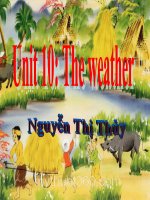- Trang chủ >>
- Văn Mẫu >>
- Văn Nghị Luận
unit 3 my birthday ct bộ gdđt 4 dương hồng hạnh thư viện giáo án điện tử
Bạn đang xem bản rút gọn của tài liệu. Xem và tải ngay bản đầy đủ của tài liệu tại đây (218.09 KB, 15 trang )
<span class='text_page_counter'>(1)</span><div class='page_container' data-page=1>
<b>Week: 4</b> <b>Date: Thứ …..ngày ….tháng …. năm 2015.</b>
<b>Period:7</b> <b>Teaching date: ...</b>
<b>UNIT 3: What day is it today?</b>
<b>Lesson 1</b>
<b>I. Objectives:</b>
By the end of this unit, pupils can
use the words and phrases related to the topic "Days of the week.
Ask and answer questions about the days of the week, using What day is it today?
<i>It’<sub>s…….</sub></i>
<b>II. Language Focus: </b>
<b>+ </b><i><b>Vocabulary:</b></i><b> Monday, Tuesday, Wednesday, Thursday, Friday, Saturday, Sunday</b>
<i><b>+ Sentence pattern</b></i>: What day is it today? - It's Monday.
<b>III. Resources: Ss’ book, recording, computer, stereo, (projector), poster, day card...</b>
<b>IV. Procedure:</b>
<b>Time</b> <b>Learning activities</b> <b>Language<sub>Focus</sub></b> <b>Modes</b>
3’
<b>Warm-up: </b>
- Spend a few minnutes revising the previous unit
by having the class sing the song Where are you
<i>from? Then write today</i>’<sub>s date on the board. </sub>
- Point to it and say Today is + (name of the day),
and write the day on the board.
- In oder to give pupils an idea of days, use a
calendar, point to each day and tell pupils that they
go to school on Mondays, Tuesdays, Wednesdays,
<i>Thursdays and Fridays, and that they study English </i>
on Mondays and Wednesdays, for example.
Spoken
Interaction.
Song: “Where
are you from"
“ Calendar
Guessing”
Whole class
Pairs
Whole class
8’
<b>1. Look, listen and repeat.</b>
- Tell pupils that they are going to read a story in
which pupils ask and answer questions about days
of the week.
<b>- Give them a few seconds to look at the four </b>
pictures and read the story. Then ask a few
questions to check comprehension, such as: Where
<i>are the pupils? Who’<sub>s the teacher? What day is it? </sub></i>
<i>What lesson is it? When is the next English lesson? </i>
(They are in the classroom. Miss Hien is the
teacher. It’<sub>s Monday. It</sub>’<sub>s the English lesson.)</sub>
Spoken
interaction Whole class
Individuals
</div>
<span class='text_page_counter'>(2)</span><div class='page_container' data-page=2>
<b>- Play the recording more than once, if necessary, </b>
for pupils to listen and repeat.
10’
<b>2. Point and say.</b>
- Tell pupils that they are going to practise asking
the question What day is it today? And answering
with It<i>’<sub>s + (name of the day).</sub></i>
- Get them to point to the name of each day on the
calendar and repeat each twice.
- Drill pupils on the questions anf answers chorally
before getting them to work in pairs. Check their
performance as a class.
<b>*Language note: Remind pupils that the days of</b>
the week start with capital letters.Write the
abbreviations of the days on the board (i.e.
Mon., Tues., Wed., Thurs., Fri., Sat. and Sun.)
and ask pupils to read aloud the days in full
forms.
<b>** Work in pairs. Ask your partners what </b>
<b>day it is today.</b>
- Tell pupils that they are going to practise asking
questions about the days of the week, using What
<i>day is it? And answering with the name of a </i>
specific day.
- Have them play a guessing game in pairs.
+ Ask each pair to write each day of the week on a
slip of paper and put the paper slips face down on
the desk.
+ Pupil 1 draws a slip of paper without looking at
it.
+ Pupil 2 asks What day is it? Pupil 1 should
guess and say a day, and then look at the paper.
+ If the answer matches the day on the paper,
he/she scores one mark and continues to draw
another slip.
+ If the answer does not match the day on the
paper, Pupil 2 has a turn. The pupil scoring the
most marks will be the winner.
New words and
structures/
function
Individuals
Pairs
Groups
8’
<b>3. Listen and tick</b>
- Tell pupils that they are going to listen to three
dialogues about days of the week and tick the
correct pictures.
- Ask them to look at the pictures to identify the
Listening
</div>
<span class='text_page_counter'>(3)</span><div class='page_container' data-page=3>
different days of the week.
- Get pupils to read aloud the days in English before
playing the recording.
- Get them to swap their answes before checking as
a class. Monitor the activity and offer help, if
necessary.
<b>Key: 1b</b> <b>2a 3c</b>
<b>Audio script:</b>
<i><b>1.</b></i> <i>Mr Loc: Hello, class.</i>
<i>Class:</i> <i> Hello, Mr Loc.</i>
<i>Mr Loc:</i> <i> What day is it today, class?</i>
<i>Class:</i> <i> It’s Thursday.</i>
<i>Mr Loc: Very good! Time for English.</i>
<i><b>2.</b></i> <i>Mai: What day is it today, Nam?</i>
<i>Nam:</i> <i> It’<sub>s Tuesday.</sub></i>
<i>Mai: So we have English today, right?</i>
<i>Nam: Yes.That’<sub>s right.</sub></i>
<i><b>3.</b></i> <i>Phong: It’<sub>s Tuesday. We have English today. </sub></i>
<i>Quan:</i> <i> No, it isn’<sub>t Tuesday. It</sub>’<sub>s Wednesday. </sub></i>
<i>We don’t have English today.</i>
<i> Phong: Oh, you’<sub>re right!</sub></i>
Pairs
Groups
5'
<b>4. Look and write.</b>
- Tell pupils that they are going to look at the table
and complete the sentences with the names of the
days.
- Give pupils a few seconds to look at the table and
the sentences. Then set a time limit for them to do
the task.
- Check the answers as a class/
- Call two pupils to read the completed text aloud.
If time allows, ask pupils more questions about the
other days of the week (e.g. I listen to music today.
<i>What day is it?)</i>
<b>Key: 1 Monday </b> <b>2 Tuesday 3 Saturday </b>
4 Sunday
Words and
structures
Whole class
Individuals
Closed – pairs
</div>
<span class='text_page_counter'>(4)</span><div class='page_container' data-page=4>
5' <b>5. Let’s sing.</b>
- Tell pupils that they are going to sing the song We
<i>have English today. </i>
- Divide the class into two groups, one group
singing the questions and the other singing the
answers.
- When pupils can sing the song confidently, ask
them to replace the days in the song with the real
days on their English timetable.
<b>*Language note: Say We have English on </b>
<i>Monday when indicationg a specific Monday, </i>
and We have English on Mondays when
idicating all Mondays.
Song
Whole class
Groups
1’
<b>* Home link: </b>
- learnt by heart the song and days.
- practice asking and answering about days in a
week.
Whole class
<i><b>Anticipated problems:</b></i>
</div>
<span class='text_page_counter'>(5)</span><div class='page_container' data-page=5>
<b>Week: 5</b> <b>Date: Thứ …..ngày ….tháng …. năm 2015.</b>
<b>Period: 9</b> <b>Teaching date: ...</b>
<b>UNIT 3: What day is it today?</b>
<b>Lesson 3</b>
<b>I. Objectives:</b>
- By the end of this unit, pupils will be able to Ask and answer questions about weekly
activities, using What do you do on + (name of the day)? I.. in the morning/in the afternoon.
<b>II. Language Focus: Spoken interaction, words and structures/ function.</b>
<i>What do you do on Fridays?</i>
<i>I go to school in the morning.</i>
<b>III. Resources: Ss’ book, recording, computer, stereo, (projector), poster, small board, </b>
timetable...
<b>IV. Procedure:</b>
<b>Time</b> <b>Learning activities</b> <b>Language Focus</b> <b>Modes</b>
3’
<b>Warm-up: </b>
Spend a few minutes revising the previous
lesson by having the class sing the song We Spoken Interaction.
</div>
<span class='text_page_counter'>(6)</span><div class='page_container' data-page=6>
<i>have English today before introducing the new </i>
lesson. Phonics in song. Whole class
7’
<b>1. Look, listen and repeat.</b>
- Tell pupils that they are going to read a story
in which the characters ask and answer
questions about their weekly activities.
- Give them a few seconds to look at the
pictures and read the text. Get them to identify
the characters and the setting of the
conversation by asking Who<i>‘<sub>s this?Where are </sub></i>
<i>they? What does Nam do on Fridays? What </i>
<i>does Quan do on Saturdays? (Nam and Quan </i>
are in the school canteen. Quan wants to know
what Nam does on Fridays. Nam answers that
he goes to school in the morning and helps his
parents at home in the afternoon. Nam then asks
Quan What do you do on Saturdays? And Quan
answers that he visits his grandparents in the
morning and plays football in the afternoon.)
- Play the recording more than once, if
necessary, for pupils to listen and repeat the
language. Do choral and individual repetition,
pointing to the character speaking.
If time allows, ask a few pairs to role-play the
conversation.
Spoken interaction
Whole class
Individuals
Individuals
Whole class
Pairs
6’
<b>2. Point and say.</b>
- Tell pupils that they are going to practise
asking and answering questions about weekly
activities.
- Let them look at the table in their books. Ask
them to identify the days when the characters do
the activities. Check comprehension.
- Point to the table and get pupils to repeat the
words in each row. Then do an example with a
pupil: What do yoy do on Mondays? I go to
<i>school in the morning. I listen to musich in the </i>
New words and
structures
Say and Respond
Individuals
Pairs
</div>
<span class='text_page_counter'>(7)</span><div class='page_container' data-page=7>
<i>afternoon. </i>
- Ask pupils to work in pairs to ask and answer
the questions, using the given text in the
bubbles and the information in the table.
- Invite a few pairs to act out the exchanges,
using facts about themselves.
10’
<b>3. Let’s talk</b>
- Tell pupils that they are going to revise what
they have learnt in Lesson 1 and 2. Get them to
work in pairs to prepare exchanges based on the
questions provided. Remind them to answer
with facts about themselves.
- Call a few pairs to act out their conversantion.
Spoken interaction
Whole class
Individuals
Pairs
Groups
6’
<b> 4. Listen and number.</b>
- Tell pupils that they are going to listen to four
dialogues about what the children do on
different days of the week and number the
pictures.
- Ask them to look at the pictures and identify
each activity.
- Play the recording more than once, if
necessary. Ask pupils to listen and number the
pictures. Tell them that they should focus on the
order of the dialogues as they hear them.
- Get pupils to swap their answer before you
check as a class. Monitor the activity and offer
help, if necessary.
<b>Key: a 3 b 2 c 4 d 1</b>
<b>Audio script</b>
<i> 1.A:Do you visit yor grandpatents on </i>
Saturdays?
<i> B : No, I don</i>’<sub>t.</sub>
<i> A: What do you do?</i>
<i> B : I</i>go to zoo.
<b> 2. A: Do you go swimming on Sundays?</b>
B : No, I don’<sub>t.</sub>
A:<b> When do you go swimming?</b>
B : On Friday afternoons.
Listening Activities
Whole class
Individuals
</div>
<span class='text_page_counter'>(8)</span><div class='page_container' data-page=8>
<i> 3. A:</i><b> Do you go to school on Saturdays?</b>
<i> B : No, I don</i>’<sub>t. I go to school from Monday</sub>
to Friday.
<b>4. A: What do you do on Tuesday aftenoons? </b>
<i> B : I stay at home. I play the guitar</i>
Groups
5’
<b>5. Look and write:</b>
- Tell pupils that they are going to complete the
sentences, using the given information.
- Give them a few seconds to look at the
timetable and read the text. Then check
comprehension.
- Set a time limit for the task and offer help, if
necessary.
- Check the answers as a class and call one or
two pupils to read aloud the completed text.
<b>Key: 1. Friday 2. go to school</b>
3. go swimming 4. Saturday
<b>5 go to school</b>
Writing activities
Words and structures
Whole class
Individuals
Pairs
2' <b>6. Let's play:</b>
- Tell pupils that they are going to play <i><b>"</b><b>Slap the</b></i>
<i><b>board"</b><b>. </b></i>
- Put the nine words on the board. Ask three
pupils to come to the front. Say one of the
words on the board. The pupil who is the
quickest to slap the correct word gets one point.
The one who gets the most points at the end of
the game will win.
- Invite another three pupils to play the game.
- To make it more challenging, you may say
words that are not on the board (and the pupils
should not slap any words).
Supportive activities
to reinforce learning
Game
- Whole
class
- Individual
1’
<b>* Home link: </b>
Practice asking and answering about weekly
activities.
Whole class
</div>
<span class='text_page_counter'>(9)</span><div class='page_container' data-page=9>
………
………
………
………
………
………
………
………
<b>Week: 5</b> <b>Date: Thứ …..ngày ….tháng …. năm 2015.</b>
<b>Period: 9</b> <b>Teaching date: ...</b>
<b>UNIT 1: Nice to see you again.</b>
</div>
<span class='text_page_counter'>(10)</span><div class='page_container' data-page=10>
<b>I. Objectives:</b>
By the end of the lesson, pupils will be able to pronounce the sounds of the letters ir, ur
and er in the words fi<i><b>r</b>st, Th<b>ur</b>sday and h<b>er </b></i>.
<b>II. Language Focus: Spoken interaction, phonics.</b>
<i>+ f<b>ir</b>st: My birthday is on the f<b>ir</b>st of July.</i>
<i>+ Th<b>ur</b>sday: I have English on Th<b>ur</b>sdays.</i>
<i>+ h<b>er</b>: Mr Loc is h<b>er</b> English teacher.</i>
<b>III. Resources: Ss’ book, recording, computer, stereo, (projector), poster, sound card ...</b>
<b>IV. Procedure:</b>
<b>Time</b> <b>Learning activities</b> <b>Language Focus</b> <b>Modes</b>
3’
<b>Warm-up: </b>
- Spend a few minutes revising the previous
lesson by calling one or two pairs of pupils to
act out the story in Lesson 2, Activity 1.
Spoken Interaction.
Role play
Pairs
8’
<b>1. Listen and repeat.</b>
- Tell pupils that they are going to practise
saying the sounds of the letters ir,ur and er in
the words first, Thursday and her.
- First, put the letters ir,ur and er on the board.
Play the recording and ask pupils to repeat a
few times. Then write the words first,
Thursday and her and the sentences on the
board. Play the recording more than once, if
necessary, and let pupils say the words and the
sentences, paying attention to the target
sounds.
- Do choral and individual repetition of the
sounds, words and phrases until pupils feel
confident.
- Get some pupils to perform in front of the
class. Check as a class and correct the
pronunciation, if necessary.
Phonics
Whole class
Individuals
Whole class
Individuals
Whole class
6’
<b>2. Listen and circle. Then say aloud:</b>
- Tell pupils that they are going to listen to the
recording and circle the right words, and then
</div>
<span class='text_page_counter'>(11)</span><div class='page_container' data-page=11>
read the sentences aloud.
- Introduce the activity and give a few seconds
for pupils to read the text.
- Play the recording once for pupils to circle
the words. Then set a time limit for pupils to
complete the sentences and check the answers
in pairs.
- Call a few pupils to read aloud the completed
sentences.
<b>Key: 1 b 2 b 3a </b>
<b>Audio script</b>
<b> 1. My birthday is on the first of July.</b>
2. We have English on Wednesdays and
Thursdays.
<b> 3. This is her class.</b>
Pairs/ groups
10’
<b>3. Let’<sub>s chant.</sub></b>
- Tell pupils that they are going to say the
chant. Follow the procedure in Teaching the
<i>unit components in the Introduction. </i>
- Have them read the chant and check
comprehension.
- Play the recording a few times for pupils to
do choral and individual repetition.
- Divide the class into two groups: one chants
the questions and the other chants the answers.
- Swap the roles after the first round. Remind
pupils to pronounce the final <i><b>s</b></i> sounds in
<i>Fridays and Saturdays.</i>
- Call two small groups of pupils to the front
of the class to say the chant. The rest of the
class claps along to the rhythm.
Spoken interaction
Whole class
Individuals
Pairs
Groups
7’
<b>4. Read and answer</b>
- Tell pupils that they are going to read the text
about Mai’<sub>s weekly activities and answer the </sub>
questions.
- Give them a few seconds to look at the
picture and ask: Who is this? When does she
<i>go to shool? (This is Mai, She goes to school </i>
Reading activities
Whole class
Individuals
Pairs
</div>
<span class='text_page_counter'>(12)</span><div class='page_container' data-page=12>
on Mondays, Tuesdays, Wednesdays,
<i>Thursdays and Fridays)</i>
- Put pupils in pairs and set a time limit for
them to read the text and answer the questions.
Monitor the activity and offer help, if
necessary.
- Get them to swap their answers and correct
them before checking as a class.
- Call a pairs ask and answer the questions.
<b>Key: 1. Her name is Mai. </b>
2. It’<sub>s Monday today.</sub>
<b> 3. No, she doesn</b>’<sub>t. She goes to school on </sub>
Mondays, Tuesdays, Wednesdays, Thursdays
and Fridays
4. She goes swimming on Saturdays and
visits her grandparents on Sundays.
5’
<b>5. Write about you</b>
-Tell pupils that they are going to answer some
questions about themselves.
- Set a time limit for pupils to do the task.
When time is up, get them to swap their
answers for peer checking. Invite one or two
pupils to read aloud their work.
<b>Key: Pupils’own answers </b>
Supportive activities to
reinforce learning
Words and structures
Whole class
Individuals
Pairs
Groups
5’
<b>6. Project</b>
- Tell pupils that they are going to interview
one their classmates about what they do at the
weekend.
- Write some sample questions on the board
and have pupils copy them down. Then do an
interview with a pupil as an example.
- Ask pupils to rehearse the interview if there
is enough time. Then ask them to do the
interview after class or over the weekned and
report the results in the next lesson.
- Teach them how to report the results.
Supportive activities to
reinforce learning Whole class
Individuals
</div>
<span class='text_page_counter'>(13)</span><div class='page_container' data-page=13>
<i><b>Example:</b></i>
<i> Good morning/afternoon, everyone. Here </i>
<i>are the results of my interviews. On Saturdays,</i>
<i>Minh plays football in the morning and listens </i>
<i>to music in the afternoon. On Sundays, he </i>
<i>goes swimming in the morning and visits his </i>
<i>grandparents in the afternoon.</i>
<i><b>***Remind them to speak slowly and clearly, </b></i>
<i><b>and keep eye contact with the audience.</b></i>
<i> Key: Pupils’own answers</i>
Groups
1’
<b>* Home link: </b>
- learnt by heart the chant
Whole class
<i><b>Anticipated problems:</b></i>
</div>
<!--links-->









